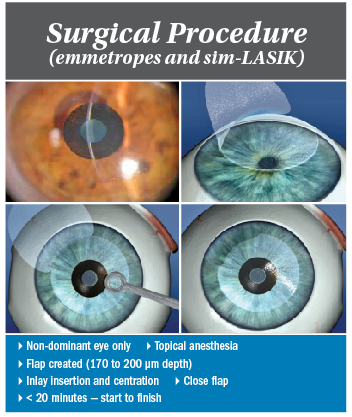Article
Inlay an option for presbyopia at corneal level
Outcomes for a cohort of patients with presbyopia with a small-aperture corneal inlay implanted find the device is well tolerated and patient satisfaction is high.
TAKE HOME:
A small-aperture corneal inlay (Kamra, AcuFocus) has provided safe, effective, and stable improvement of near and intermediate vision in emmetropic presbyopes followed for 5 years.

(Images courtesy of Günther Grabner, MD)
San Francisco-Outcomes for a cohort of patients with presbyopia with a small-aperture corneal inlay implanted find the device is well tolerated and patient satisfaction is high.
Implantation of the device (Kamra, AcuFocus) improves near and intermediate vision in presbyopic emmetropes, while having minimal effect on distance vision, and its benefits remain stable during follow-up of 5 years.
“The small-aperture corneal inlay is an effective and safe treatment for presbyopia, and patient satisfaction with the inlay is high,” said Günther Grabner, MD, at the annual meeting of the American Society of Cataract and Refractive Surgery.
“The inlay is well-tolerated, but can be removed if desired, and I believe it is an excellent option for treating presbyopia at the corneal level,” said Dr. Grabner, professor of ophthalmology and director, Paracelsus Medical University Eye Clinic, Salzburg, Austria.

Dr. Grabner
He presented outcomes for the first cohort of patients with the small-aperture corneal inlay he implanted beginning in September 2006. The inlay available at that time measured 10 μm in thickness and contained 1,600 microperforations to allow nutrient flow. The current generation of the inlay is only 5-μm thick and features 8,400 microperforations.
The series included 32 patients, all of whom had complete follow-up to 4 years, and 17 of whom had reached the 5-year visit. The implantations were done in the nondominant eye under a femtosecond-created flap at an intended depth of 170 μm using topical anesthesia. Mean age of the patients at time of implantation was 51 years.
Carefully selected population
“This was a very carefully selected population for enrollment in the multicenter FDA study, and we screened about 300 patients to identify these 32 individuals who met the strict inclusion criteria,” Dr. Grabner said.
Data from follow-up at 4 years for the eye with the inlay showed near uncorrected visual acuity (UCVA) improved from J7/8 at baseline to J2; intermediate UCVA improved from 20/40 preoperatively to 20/25. The patients lost about 1 line on average for distance UCVA, from 20/16 to 20/20. No eye had distance UCVA worse than 20/32, and binocular distance UCVA stayed unchanged at 20/16. Mean spherical equivalent changed from 0.19 D preoperatively to 0.03 D.
“For the patients seen at 5 years, the results in the inlay eye remain stable, but we can see some age-related loss in near and intermediate UCVA in the fellow eye,” Dr. Grabner said.
He added that near vision function was also evaluated using the Salzburg Reading Desk, and the results showed improvements in reading acuity and speed with a decrease in preferred reading distance.
“With this test we have objective evidence of improved near vision function,” Dr. Grabner said.
Ten patients completed a satisfaction questionnaire at 5 years. When asked if they would have the surgery again, nine responded “yes” and one said “maybe.” There were no reports of significant night symptoms. Near vision quality was rated on a scale of 0 (bad) to 7 (very good), and the average score was 5.7.
Minimal complications
Complications in this first series of patients included one case of epithelial ingrowth requiring repeated flap lift, but successfully treated. There were two cases of decentered inlays associated with decreased distance UCVA, and one patient developed a hyperopic shift (+2.5 D) associated with inadvertent superficial placement of the inlay.
The decentered inlays were repositioned at 7 months after initial surgery, vision improved within 1 month, and at 30 months, the patients achieved J2 near UCVA and 20/20 distance UCVA. The superficially placed inlay was removed after 4 years.
“The inlay should be centered over the estimated visual axis and within about 300 μm of target to achieve optimum visual acuity,” Dr. Grabner said. “Recentration is possible, but it is best done early.
“In the patient with a hyperopic shift, the inlay was placed at 130 μm instead of the intended depth of 170 μm,” he added. “The eye developed marked topographic changes that we think were the result of epithelial cytokines stimulating the keratocytes and leading to some minimal haze.”
Well tolerated during long-term follow-up
The inlay continues to be well tolerated during long-term follow-up. No irritation or inflammatory reactions have been observed, and in testing at 12 months, binocular photopic and mesopic contrast sensitivity were within normal limits.
The inlay does not interfere with examination or treatment of the anterior chamber angle or posterior segment, Dr. Grabner noted.
“I was concerned about being able to see the macula in these older patients who may be developing age-related macular degeneration or diabetic macular edema,” he said. “However, optical coherence tomography [imaging] of the retina is not a problem and one can also do a fundus exam without pupil dilation.”
In addition to modifications of the inlay itself, there have been changes in the inlay placement procedure and expansion of potential candidates. Currently the inlay can also be placed into a femtosecond laser-created pocket, and using that approach, it can be simultaneously combined with LASIK in patients needing ametropic correction. The inlay can also be placed into a pocket to correct presbyopia in postLASIK or pseudophakic eyes. Dr. Grabner added that some therapeutic applications may emerge in the future with the introduction of a smaller-aperture inlay.
Günther Grabner, MD
Dr. Grabner has received travel grants and speakers fees from AcuFocus.
Subscribe to Ophthalmology Times to receive the latest clinical news and updates for ophthalmologists.
Newsletter
Don’t miss out—get Ophthalmology Times updates on the latest clinical advancements and expert interviews, straight to your inbox.




